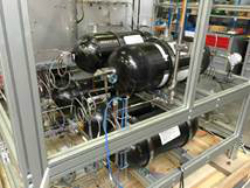Hydrogen refuelling under three minutes
The EU considers finding alternatives to petrol-powered vehicles as a key element in its plans to reduce carbon dioxide (CO2) emissions. One significant step along this way is the use of fuel cell-powered vehicles that have near-zero lifecycle CO2 emissions. Even highly optimised internal combustion engines are not likely to emit less than 110 grams of CO2 per kilometre. Major automotive manufacturers have hydrogen fuel cell vehicles ready for mass production. However, building a new hydrogen refuelling infrastructure is a major impediment to the successful rollout of the new vehicles to the market. Ensuring the efficiency of the refuelling process under all different ambient conditions is challenging. The HYTRANSFER(opens in new window) (Pre-normative research for thermodynamic optimization of fast hydrogen transfer) project was launched with financial support from the EU to improve the fuelling of hydrogen vehicles. The ultimate aim was to reduce investment and operating costs while increasing the reliability of refuelling stations and reducing maximum refuelling time. Experiments have shown that the heat transfer between hydrogen gas and the tank wall is rather ineffective. Even when the hydrogen inside the tank reaches a temperature of 85 °C (the maximum temperature specified in regulation, codes and standards for on-board tanks), the tank wall temperature will remain lower. Using thermodynamics to determine the relation between injected hydrogen, filling parameters like the hydrogen flow rate and ambient temperature can help optimise the hydrogen transfer process. As Jan Zerhusen from Ludwig-Bölkow-Systemtechnik GmbH in Germany, the new project coordinator explained: 'a significantly deeper understanding of temperature conditions within the involved tanks and tank systems was gained by an extensive experimental campaign in combination with thorough thermodynamic modelling. Based on this new knowledge, improvements in hydrogen refuelling were proposed.' He went on to add that 'a new and innovative protocol for vehicle refuelling and its resulting regulations, codes and standards recommendations were developed and presented to relevant stakeholders. With this proposed protocol, the investment and operating cost of a hydrogen refuelling station can be reduced significantly. Moreover, the protocol enables shorter refuelling times which positively impacts on customer experience.' Specifically, the HYTRANSFER protocol entails a significant reduction in the pre-cooling temperature from -40 °C to about -20 °C, allowing for cutting down investment and operation costs of the pre-cooling unit, which is a central part of refuelling stations. Station operators could increase their profits by as much as EUR 20 000 annually. For the customers, the resulting reduced refuelling time, as well as hydrogen prices, could provide the incentive to adopt or continue using hydrogen-powered vehicles. Zerhusen noted that 'we are currently at the beginning of building a hydrogen refuelling infrastructure as well as of the fuel cell vehicle rollout. A delayed introduction of the proposed refuelling protocol may require changes to existing stations or vehicle tanks, causing unnecessary costs.' Along these lines, the HYTRANSFER team completed a series of tests on tanks and tank systems supplied by industrial partners. Optimisation opportunities for the hydrogen transfer process within existing regulations, codes and standards and state-of-the-art technology were also analysed to develop a path forward for the new refuelling protocol to international bodies.



